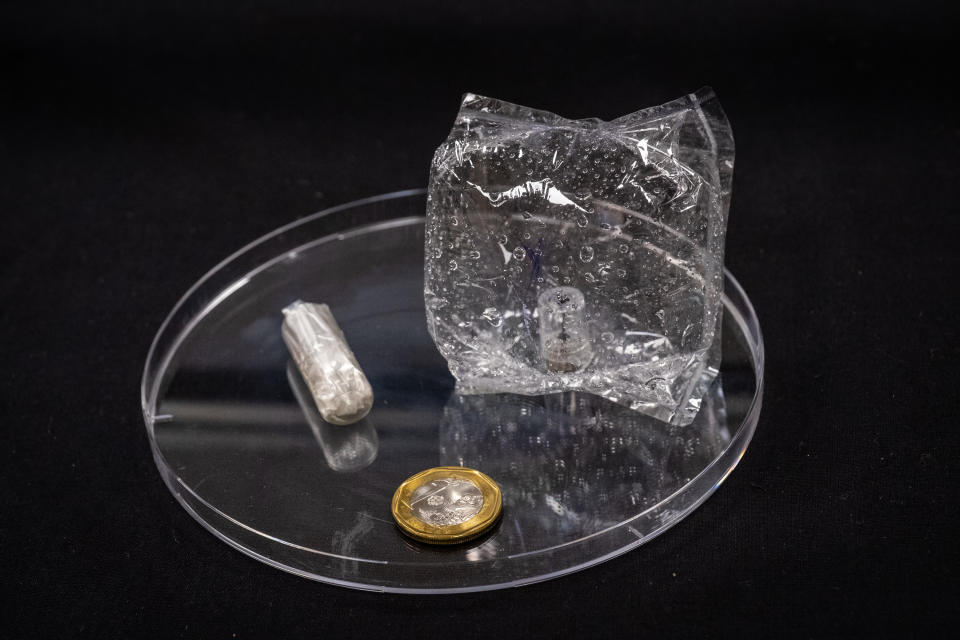Made-in-Singapore weight loss pill with self-inflating balloon may be on sale by 2024

SINGAPORE — A made-in-Singapore weight loss capsule with a self-inflating balloon mechanism may hit the shelves of pharmacies as early as 2024, and it could help tackle obesity.
The “non-invasive” breakthrough could replace a procedure that moderately obese patients or those too ill to undergo surgery typically opt for: a 500ml intragastric balloon that is inserted into the stomach via endoscopy under sedation, to make them feel fuller faster and limit their food intake.
The EndoPil capsule is designed to be ingested orally with water – just like a pill – and can be self-inflated with a handheld magnet to induce a “sense of fullness”.
The prototype, seven years in the making, is developed by a four-member team led by Professor Louis Phee, dean of engineering at the Nanyang Technological University (NTU), and Professor Lawrence Ho, senior consultant at National University Hospital.
On Wednesday (24 April), they demonstrated how the capsule worked at the Robotics Research Centre in NTU.
Measuring around 3cm by 1cm, the EndoPil comes with an outer gelatine casing containing a deflated balloon, an inflation valve with a magnet attached, as well as citric acid and baking soda stored in separate compartments in an inner capsule.
When it enters the stomach, gastric acid will break open its outer gelatine casing.
The EndoPil’s inflation valve is then located and “opened” with an external magnet, a step that prevents it from prematurely inflating in the esophagus or inflating too late after it enters the small intestines.
Once the valve is opened, the citric acid and baking soda react to produce carbon dioxide, which fills up the balloon. This allows it to float to the top of the stomach, where it is more sensitive to fullness.
The balloon can be inflated to 120ml within three minutes and deflated to a size small enough to enter the small intestines to be passed out naturally.
Currently, the capsule can only be deflated magnetically.
EndoPil is expected to be a “very affordable” product that can be easily bought at pharmacies, like Guardian, by “anyone who wants to lose a few kilos”, said Prof Phee.
“This is something when done correctly, it’s like an off-the-shelf product, where you just have to go to the general practitioner to administer it and you go on to live your life,” he added.
In contrast, a patient needs to be of a certain level of obesity before doctors are allowed to insert an intragastric balloon via endoscopy.
The procedure can also cost more than $1,000 and may require the patient to be hospitalised, said Prof Ho, who is also the director of the Centre for Innovation in Healthcare at the National University Health System.
To allow for shorter treatment cycles where the stomach does not grow used to the balloon’s presence, an EndoPil should be removed within a month compared with six months for intragastric balloons, he added.
As the space-occupying effect in the stomach is achieved gradually, common side effects suffered by patients relying on intragastric balloons, such as nausea and vomiting, can be avoided. Up to 20 per cent of such patients require early balloon removal due to intolerance, according to the Health Promotion Board and the Ministry of Health’s clinical practice guidelines on obesity.
“With this new concept, it will be more natural for the patient. We can put it in and take it out without too much trouble,” said Prof Ho, adding that this will allow users to tailor consumption of the EndoPil to suit a personalised weight-loss regime.
Beyond weight loss, the capsule could be used in other ways such as facilitating the slow release of drugs, monitoring the pH level for diabetic patients and tracking tumour bleeding, said Prof Phee.
The World Health Organization estimates that 1.9 billion adults in the world were overweight in 2016, with 650 million suffering from obesity.

More human trials needed
An earlier and larger prototype of the EndoPil was first inserted in a pig for a pre-clinical study more than five years ago. The study’s findings showed that the pig lost 1.5kg a week later.
In comparison, a control group of five pigs that were not inserted with the prototype had gained weight.
Last year, the mechanism was trialed successfully on a healthy patient volunteer in Singapore, with the capsule inserted into her stomach through an endoscope. The balloon inflated in the patient’s stomach with no resulting discomfort or injury.
A US patent for the balloon-inflating mechanism was granted in 2016, while a new US patent had been filed for the latest version of EndoPil.
Prof Phee and Prof Ho, who plan to set up a start-up company to commercialise the capsule, said there is much work to be done.
The team is currently working on programming the capsule to biodegrade and deflate after a stipulated period of time, before it gets expelled by the body’s digestive system.
“We are still experimenting on various materials. First of all, it’s not easy to find a balloon-type of material that can hold carbon dioxide (and is compact). Carbon dioxide diffuses through a lot of materials,” said Prof Phee.
The team plans to conduct human trials in Singapore in a year’s time, where an improved and possibly smaller prototype will be taken orally.
In the “best case” scenario, EndoPil would be commercially ready in five years, Prof Phee added.
More Singapore stories:
NTU scientists develop ‘fat-burning’ patch to combat obesity
NSL, EWL re-signalling project complete, new train testing centre to open by 2022: Khaw
British man caught on video punching Roxy Square security guard charged


